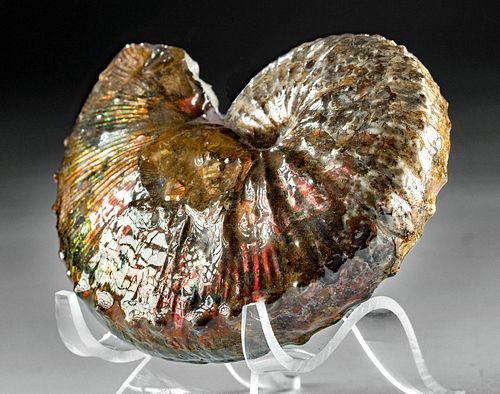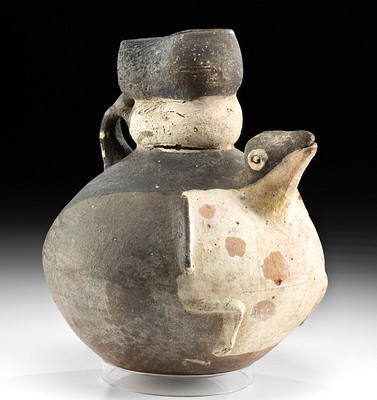Beautiful Fossilized Ammonite w/ Ammolite Iridescence
Lot 9
About Seller
Artemis Fine Arts
686 S Taylor Ave, Ste 106
Louisville, CO 80027
United States
Selling antiquities, ancient and ethnographic art online since 1993, Artemis Gallery specializes in Classical Antiquities (Egyptian, Greek, Roman, Near Eastern), Asian, Pre-Columbian, African / Tribal / Oceanographic art. Our extensive inventory includes pottery, stone, metal, wood, glass and textil...Read more
Estimate:
$900 - $1,350
Absentee vs Live bid
Two ways to bid:
- Leave a max absentee bid and the platform will bid on your behalf up to your maximum bid during the live auction.
- Bid live during the auction and your bids will be submitted real-time to the auctioneer.
Bid Increments
| Price | Bid Increment |
|---|---|
| $0 | $25 |
| $300 | $50 |
| $1,000 | $100 |
| $2,000 | $250 |
| $5,000 | $500 |
| $10,000 | $1,000 |
| $20,000 | $2,500 |
| $50,000 | $5,000 |
| $100,000 | $10,000 |
| $200,000 | $20,000 |
About Auction
By Artemis Fine Arts
Oct 28, 2021
Set Reminder
2021-10-28 12:00:00
2021-10-28 12:00:00
America/New_York
Bidsquare
Bidsquare : Fauna, Flora, Stone & Bones - Fall Edition
https://www.bidsquare.com/auctions/artemis-gallery/fauna-flora-stone-bones---fall-edition-7768
Join us for a very special early Fall auction featuring fabulous fossils, rocks, and minerals, plus art depicting flora and fauna from antiquity to present day. This is one sale you won't want to miss! Artemis Fine Arts info@artemisgallery.com
Join us for a very special early Fall auction featuring fabulous fossils, rocks, and minerals, plus art depicting flora and fauna from antiquity to present day. This is one sale you won't want to miss! Artemis Fine Arts info@artemisgallery.com
- Lot Description
Ancient Seas, North America, Paleozoic to Late Cretaceous period. ca. 400 to 66 million years ago. This is a stunning fossilized ammonite shell that has opalized and developed shimmering ammolite formations. The shell is preserved with great details such as the textual ridges and slightly recessed spiral. On the verso, the shell was excavated with a cut away exterior - revealing the inner chamber that was once organic tissue - the body and tentacles - but is now a solid stone matrix that contains additional and separate ammonite shell fragments and imprints that fossilized and settled with in the main ammonite. These pieces have also developed a red ammolite iridescence which contrasts with the dark surrounding stone of the chamber. The fossilization process can result in the "opalization" which creates ammolite, the gemstone formed by ammonite shells - this is a gorgeous example that has a clear coating to protect the ammolite. Size: 3.75" L x 4.75" W (9.5 cm x 12.1 cm); 4" H (10.2 cm) on included custom stand.
Provenance: private Hagar collection, Wildwood, Missouri, USA
All items legal to buy/sell under U.S. Statute covering cultural patrimony Code 2600, CHAPTER 14, and are guaranteed to be as described or your money back.
A Certificate of Authenticity will accompany all winning bids.
PLEASE NOTE: Due to recent increases of shipments being seized by Australian & German customs (even for items with pre-UNESCO provenance), we will no longer ship most antiquities and ancient Chinese art to Australia & Germany. For categories of items that are acceptable to ship to Australia or Germany, please contact us directly or work with your local customs brokerage firm.
Display stands not described as included/custom in the item description are for photography purposes only and will not be included with the item upon shipping.
#168042Professionally prepared. Clear fixative coating applied to ammolite areas. Verso has loss to main ammonite shell but shows the inner material and other ammonite shell fragments. Nice areas of iridescent ammolite.Condition
- Shipping Info
-
All shipping is handled in-house for your convenience. Your invoice from Artemis Gallery will include shipping calculation instructions. If in doubt, please inquire BEFORE bidding for estimated shipping costs for individual items.
-
- Buyer's Premium



 EUR
EUR CAD
CAD AUD
AUD GBP
GBP MXN
MXN HKD
HKD CNY
CNY MYR
MYR SEK
SEK SGD
SGD CHF
CHF THB
THB














